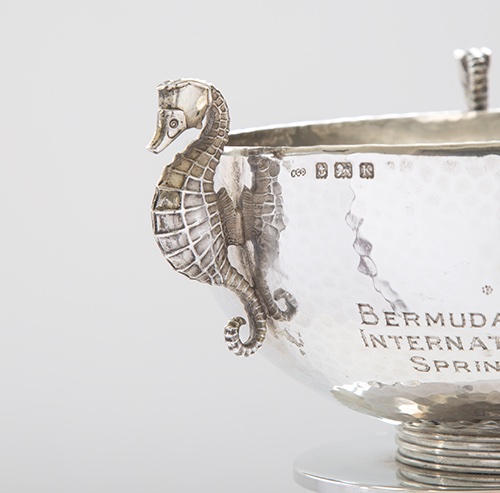Sea as Muse, Now on Exhibit
 For artists, inspiration can come from anywhere, but in the late 19th century, wood carvers and silversmiths often drew it from the sea. In the fourth and final exhibit funded by a generous grant from the Henry Luce foundation, the Sea as Muse exhibit will display 115 beautiful objects inspired by the sea, including anything from sea life to sea creatures to the yachting and sailing life.
For artists, inspiration can come from anywhere, but in the late 19th century, wood carvers and silversmiths often drew it from the sea. In the fourth and final exhibit funded by a generous grant from the Henry Luce foundation, the Sea as Muse exhibit will display 115 beautiful objects inspired by the sea, including anything from sea life to sea creatures to the yachting and sailing life.
Sea as Muse opened on September 18th and was curated by Katherine Hijar. The exhibit will showcase more than 40 silver trophies, many of which were locally made in either Meriden, Connecticut or Providence, Rhode Island. Both cities were home to some of the largest silver manufacturing companies in the country during that time.
A lot of the trophies were awards for yachting and sailing competitions, and while previous exhibits focused on the yachts themselves and their often-famous owners, this exhibit offers a fresh perspective, focusing on the fine art and intricate design of the treasures themselves, as well as the stories behind them.
One trophy in particular has quite the unusual backstory. In big regattas during the late 1800s, it was common to give the owners of losing yachts a presentation piece as recognition of their participation. However, the Livonia trophy, was awarded by anonymous Americans in London who clearly intended to mock the Livonia’s owner.
It commemorates the results of a yachting challenge to the New York Yacht Club by James Ashbury of England, who was determined to win the America’s Cup for the Royal Harwich Yacht Club. In a series of seven races in October 1871, Ashbury’s Livonia competed against two American yachts, winning just one race against the Columbia. Ashbury contested the result but after an investigation, the New York Yacht Club affirmed its original decision. This trophy was not awarded by the New York Yacht Club however, as the engraving tells us that it was commissioned and presented to Ashbury by “Americans in London” as acknowledgment of Ashbury’s single win. The fact that it only mentions one win out of five and that both Ashbury’s name and the name of his yacht were misspelled all point towards this trophy being one very expensive insult. The figures on top of the cup further suggest this, as the standing figure is Columbia, representing the United States, and the figure that kneels before her is Britannia, representing Great Britain. These two figures were depicted frequently in art and political cartoons that aimed to show that both nations were equally great, however on this trophy, Britannia shows subservience to Columbia—a subtle but clear suggestion of Britain’s—and Ashbury’s—inferiority.
Unsurprisingly, Ashbury refused the cup, and it was returned to the unknown Americans who gave it to him.
Another piece in the collection, the “Palladium Trophy” was named after The Daily Palladium, which was once a newspaper in New Haven, Connecticut. The piece was made by Rogers, Smith & Co. in 1887 in Meriden, Connecticut and was donated by the paper. It is widely recognized as the “Neptune Trophy” for the statue of the Roman god of freshwater and the sea that sits atop it.
The exhibit also includes a few masterpieces from The Gorham Manufacturing Company and Tiffany, including two Astor Cups, named for John Jacob Astor the IV, who donated a large sum of money to the New York Yacht Club to pay for two trophies a year that would bear his name.
While much of the exhibit showcases fine silver, there is also an incredible wood carving portion, featuring items from the yacht Aloha II, which was owned by wealthy American Arthur Curtiss James, a true yachtsman who loved everything about yachting and the sea, including the active yachting social life. The carvings on display are from his deck saloon and include a series of magnificently carved wood panels that illustrate excerpts from an ancient Norse epic poem, “The Volsunga Saga.”
An interesting discovery during Hijar’s research was the fact that many of the artists and designers during that time were immigrants. Scandinavian artist Karl von Rydingsvard is responsible for the woodwork on the Aloha II, including furniture such as hand carved chairs that will also be on display.
From dolphins to mermaids and seaweed to sea urchins, come enjoy this exhibit and gain a deeper appreciation of the sea and its beauty, while exploring the wonder of life on the sea.



